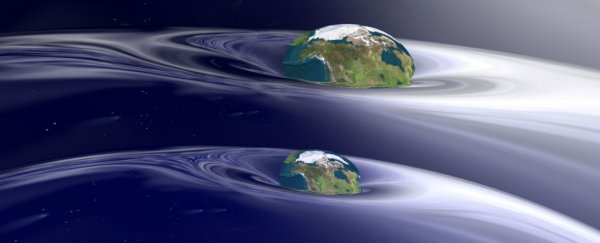The idea of a multitude of parallel universes existing alongside our own is not new, but trying to find evidence of this phenomenon is proving about as tricky as you might expect. But one cosmologist thinks he might have found evidence of a parallel universe brushing against our own as far back at the beginning of time.
To appreciate what Ranga-Ram Chary from the California Institute of Technology has found, it's important to first understand how our own Universe came into being. For hundreds of thousands of years after the Big Bang, the particles that existed were too hot and energetic to form into atoms: the point at which this started happening, some 300,000 years after the Big Bang, is known as recombination. It also marks the time when cosmic background radiation (CMB) started spreading through the Universe - a signal scientists use to look back into time and formulate their theories.
What Chary has spotted is a bump or a 'bruise' in this cosmic background radiation - and that could mean a collision with a parallel universe. Cosmologists believe that the 'bubbles' of separate universes could be colliding with each other, depositing some material along the way, just like normal soap bubbles bumping into each other would.
So can we start plotting a course to this brand new universe right away? Well, not exactly. Interpreting CMB signals is notoriously difficult, and Chary himself believes there's a 30 percent chance that what he's found is just background noise and not a tell-tale sign of a neighbouring universe at all. It could also be a large spot of space dust.
"I suspect that it would be worth looking into alternative possibilities," David Spergel from Princeton University told Joshua Sokol at New Scientist. "The dust properties are more complicated than we have been assuming, and I think that this is a more plausible explanation."
"Joseph Silk of Johns Hopkins University in Baltimore, Maryland, is even more pessimistic, calling claims of an alternate universe 'completely implausible'," adds Sokol. "While he thinks the paper is a good analysis of anomalies in Planck data, Silk also believes something is getting in the way. 'My view is that they are almost certainly due to foregrounds.'"
The data used by Chary was taken from the European Space Agency's powerful Planck telescope. By subtracting CMB models from Planck's picture of the Universe, he discovered patches of signals some 4,500 times brighter than they should have been, based on the number of protons and electrons scientists believe existed in the very early universe.
At this stage, it's just an hypothesis, and looking billions of years back into the past isn't at all straightforward, but progress is being made all the time. Chary told Jennifer Ouellette at Gizmodo that he hopes to have more comprehensive results within a couple of years, though his ideas might not be proved one way or the other until the next generation of space scanning technology comes online (estimated at 15 to 20 years).
"Unusual claims like evidence for alternate universes require a very high burden of proof," he writes in his report, published online at arXiv.org. "Searching for these alternate universes is a challenge."
As far as challenges go, Chary sure has a big one on his hands.
